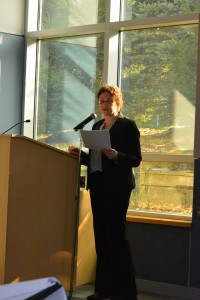- About Ramapo
- Academics
- Admissions & Aid
- Student Life
- Athletics
- Alumni
- Arts & Community
- Quick Links
- Apply
- Visit
- Give
TWO PROGRAMS HELD TO COMMEMORATE THE END OF WORLD WAR ONE
(PDF) (DOC) (JPG)November 12, 2014
(Mahwah, N.J.) To commemorate of the 100th anniversary of the end of the First World War on November 11, 1914, two scholars presented work in separate programs under the auspices of the Center for Holocaust and Genocide Studies. They both addressed the treatment of Jews during the war and indicated that anti-Semitism was going to be a potent political force in European for decades to come.
 Focusing on the infamous Jew Census (Judenzälung) of 1916 that right-wing nationalist elements in Germany managed to push through the Reichstag in an attempt to prove that Jews were shirkers and profiteers, at the Center’s annual Kristallnacht commemoration with Temple Beth Haverim Shir Shalom on November 8 Dr. Peter Appelbaum made it clear that the net results were widespread disenchantment among German-Jewish war veterans and a propaganda victory for the anti-Semitic right. Since the census proved just the opposite and was not released until after the war, myths about Jewish disloyalty and cowardice proliferated, becoming a standard trope of anti-Semitic propaganda throughout the Weimar Republic.
Focusing on the infamous Jew Census (Judenzälung) of 1916 that right-wing nationalist elements in Germany managed to push through the Reichstag in an attempt to prove that Jews were shirkers and profiteers, at the Center’s annual Kristallnacht commemoration with Temple Beth Haverim Shir Shalom on November 8 Dr. Peter Appelbaum made it clear that the net results were widespread disenchantment among German-Jewish war veterans and a propaganda victory for the anti-Semitic right. Since the census proved just the opposite and was not released until after the war, myths about Jewish disloyalty and cowardice proliferated, becoming a standard trope of anti-Semitic propaganda throughout the Weimar Republic.
Similarly, in a talk given to an audience of students, faculty, and community members on November 11 (Veterans Day) with the title, “The World War One Refugee Crisis in Austria-Hungary,” Dr. Rebekah Klein-Pejšová of Purdue University showed how myth-making was a constant element in the agitation and propaganda against the influx of Jews to Hungary from the war zone in their native Austrian Poland. To this day, people in Hungary believe that hoards of Eastern Jews descended on their country, bringing with them everything from disease and squalor to black marketeering and Bolshevism.
 Klein-Pejšová also revealed that the refugees not only had to deal with bureaucratic rigidity, prejudice and outright hatred from non-Jews, but also a certain amount of hostility and indifference from members of their own community. Not surprisingly, much depended on local political, cultural, and religious circumstances. In eastern regions of Hungary, including Slovakia, where traditional Judaism was much more the norm, the Jewish community was much more engaged in trying to ameliorate the refugee situation than in Budapest and elsewhere in the west where modernization was much more widespread.
Klein-Pejšová also revealed that the refugees not only had to deal with bureaucratic rigidity, prejudice and outright hatred from non-Jews, but also a certain amount of hostility and indifference from members of their own community. Not surprisingly, much depended on local political, cultural, and religious circumstances. In eastern regions of Hungary, including Slovakia, where traditional Judaism was much more the norm, the Jewish community was much more engaged in trying to ameliorate the refugee situation than in Budapest and elsewhere in the west where modernization was much more widespread.
Both presentations made evident that the First World War and its aftermath provided a rich seedbed for the greater disaster that came in the form of the rise of Hitler and the Second World War.
Peter Appelbaum M.D., Ph. D has authored and co-authored more than 1,000 scientific articles and presentations to scientific audiences world-wide during his career as a clinical microbiologist and antibiotic researcher. His interest in German and other languages as well as in modern Jewish history led to his research on the experience of Jews in the German army during World War I. His first book, Loyalty Betrayed: Jewish Chaplains in the Germany Army during the First World War, as the title indicates, details the story of accomplishments and travails of the rabbis who served with German military during World War I.
Rebekah Klein-Pejšová is the Jewish Studies assistant professor of history at Purdue University. She is the author of the forthcoming book “Mapping Jewish Loyalties in Interwar Slovakia.” Her recent publications include articles in Austrian History Yearbook, Shofar, and AJS Review. She is a contributor to Europe on the Move, 1914-1918, a collaborative book project that explores the First World War refugee crisis.
E-News Archives
| 2023 | 2022 | 2021 | 2019 | 2018 | 2017 | 2016 | 2015 | 2014 | 2013 | 2012 | 2011 | 2010 | 2009 | 2008 | 2007 |Copyright ©2025 Ramapo College Of New Jersey. Statements And Policies. Contact Webmaster.

Follow Us!